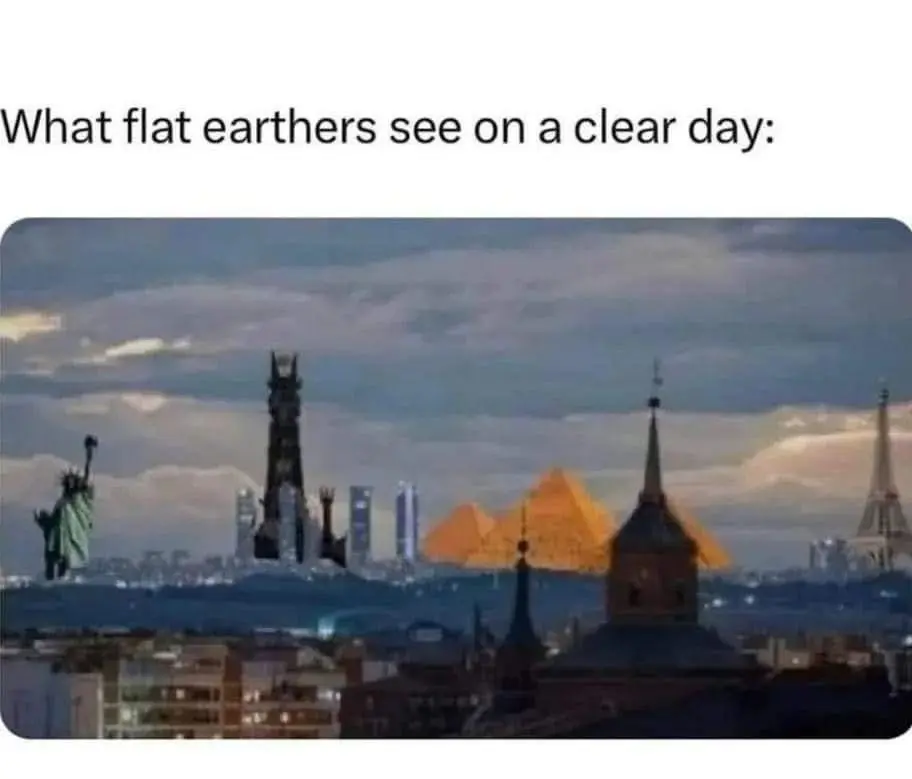Checkmate, Round Earthers 🌍
-
It has been remade
Pray I do not remake it further.
-
Basically, you could see for a long way but your eyeballs suck so it largely doesn't matter. Even with the best telescope and optics on a perfect day you will be limited by the gasses in the atmosphere which scatter light.
Also, Barad-dûr was destroyed when Frodo threw the One Ring into the fires of Mount Doom so it wouldn't be there.
you will be limited by the gasses in the atmosphere
Lol if you're going to abandon the round earth theory, you might as well dump the concept of an atmosphere, too.
-
you will be limited by the gasses in the atmosphere
Lol if you're going to abandon the round earth theory, you might as well dump the concept of an atmosphere, too.
Right, more of an atmo-plane at that point.
-
Where would the photographer be here that they can see the pyramids with the Statue of Liberty (what a joke) is to the left of them? Saudi Arabia maybe?
Maybe somewhere in Canada
-
Maybe somewhere in Canada
Seems you have better spatial planning than me as the tool that should not be named said Saudi is out, but Canada is a good shout.
-
Right, more of an atmo-plane at that point.

-
This post did not contain any content.
I'm an inverse round earther. The earth is round, only we are on the wrong side of it.
-
It's very far away and we're still seeing the light from when it still stood
Oh, right. Makes sense.
-
This post did not contain any content.
They probably think that your render distance is limited for [insert reason here] or something.
-
Where would the photographer be here that they can see the pyramids with the Statue of Liberty (what a joke) is to the left of them? Saudi Arabia maybe?
I can see the eye of sauron. My guess is middle earth
-
This post did not contain any content.
If you were standing on the Liberty National Golf Club in New Jersey about 2km from the Statue of Liberty (height 93m), from the bottom to the top it would be about 2.5 degrees.
If you were looking at the Eiffel Tower at 6000 km away from NJ, and the earth were flat, the Eiffel Tower (height 312m), from the bottom to the top it would be about 0.003 degrees from bottom to top. If you could line it up so that you could see the Statue of Liberty and the Eiffel Tower at the same time, the Eiffel Tower would appear to come up to the first 10 cm of the Statue of Liberty's base. That's actually a little bigger than I would have expected, but still tiny.
I wonder if, even with binoculars, someone could even resolve something that small. Ignoring everything like ocean waves interfering, vegetation getting in the way and atmospheric interference, my guess is that it would be just too small to be seen from that far away without some ultra-powerful telescope.
-
Okay, I want to be able to simulate what the world would actually look like from a vantage point where you could see the whole world unwrapped like this.
I think unless you are up very high, most tall distant things are covered by buildings and mountains.
If you are in, say, the eastern part of cairo, you might be only 20km from the pyramids of giza. However if there was a normal sized house even just 1km away in the same direction, it would be big enough to cover the pyramids entirely.
Then there is also mountain ranges. Even if you were on top of the Burj Khalifa with a really good telescope, multiple mountains would block your view. You would need to be multiple Burj Khalifa's higher up in the air to see the pyramids of Giza from there.
And then there's clouds, fog, dust, smog and last but not least atmospheric scattering of light, obscuring things more and more the further away they are.
-
They probably think that your render distance is limited for [insert reason here] or something.
It kind of is, if the world were flat it wouldn't look much different I reckon, except when you're in exceptionally flat places like oceans or large lakes. And even then, due to clouds, fog, dust, smog and atmospheric scattering, things far away are harder to see



